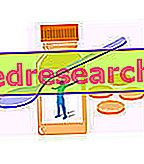Generality
Mononucleosis is an infectious disease that affects the body following the transmission of a virus. This viral agent is transmitted, in most cases, by saliva; for this reason, the infection is also known as the "kissing disease" .

The responsible of the mononucleosis is, in fact, the Epstein-Barr virus (EBV), belonging to the herpes virus family.
The prevalent symptoms of the disease are: asthenia (feeling of exhaustion), high fever, swollen lymph nodes (especially those of the neck) and pharyngitis which, within a week, becomes very intense. After the clinical presentation of mononucleosis, it heals, in most cases, without too many complications: in adolescents and adults the manifestations tend to disappear within a few weeks. The only disorder that tends to persist, even for several months after infection, is a feeling of generalized fatigue, while the most feared complication is an enlarged spleen rupture.
What's this
Mononucleosis: what is it?
Mononucleosis is a disease of viral origin, acute and contagious, also known for the frequency with which it is observed in adolescents. Infection, in fact, is usually transmitted through saliva; for this reason, mononucleosis is also known as " kissing disease " or " kissing disease ". Less often, the disease is contracted following the sharing of objects (from cutlery to glasses) that come into contact with an infected person.
Causes and Risk Factors

What are the Causes of Mononucleosis?
Mononucleosis is a disease caused by Epstein-Barr virus (EBV) . This viral agent belongs to the same family of herpes viruses, which is the same one that includes the pathogens responsible for chickenpox, cold or genital herpes and shingles.
In the same way as his "relatives", once the infection is contracted, the EBV virus remains forever latent in the human body and may reappear periodically.
Why is it called "Mononucleosis"?
The name derives from the body's reaction to infection : the presence of Epstein-Barr virus in the body stimulates the production of white blood cells and, in this case, of mononuclear cells (with a single nucleus) or monocytes in the blood, usually present in small number.
Contagiousness: how easily is Mononucleosis transmitted?
Mononucleosis is a disease of modest infectiousness, which affects mainly individuals between the ages of 15 and 35.
Who is most at risk?
Mononucleosis preferably affects adolescents and children, but adults are not exempt at all.
Infection is more easily contracted when our immune system is weakened (for example, after a particularly debilitating illness or during a period of intense stress).
Mononucleosis: how widespread is it?
Widespread throughout the world, mononucleosis affects 50% of individuals living in industrialized countries by adolescence, while it appears earlier in developing countries.
Given the infectious rate, mononucleosis can cause small epidemics only in particular conditions, such as:
- Close contact with affected individuals;
- Overcrowding;
- Bad hygienic conditions.
According to recent estimates, around 90% of the adult world population, with no particular predilection for sex, comes into contact with the Epstein-Barr virus throughout their lives. Most of these people have developed specific antibodies, without ever having experienced any signs of infection.
How is EBV infection acquired?
The infection can be direct and take place through saliva (via oro-pharyngeal) and urine, unprotected sexual relations or blood and blood transfusions. However, the infection can also be contracted indirectly through, for example, the common use of contaminated objects such as cutlery, glasses, plates and toys, as well as with widespread coughing droplets.
Infectiousness can persist for a long time, since the pharyngeal elimination of the virus persists up to a year after infection. It must also be considered that, during periods of virus reactivation, healthy carriers can become a source of infection. In any case, if you have already been infected once, any subsequent contact with a person with mononucleosis will have no consequences.
Symptoms and Complications
To learn more: Symptoms Mononucleosis »Mononucleosis: how does it manifest itself?
The main symptoms of mononucleosis are similar to those of a common winter illness such as, for example, influenza and include:
- Sense of exhaustion ;
- Sore throat ;
- Fever ;
- Enlarged lymph nodes .
The manifestations of the disease are due both to the increased production of mononuclear cells (lymphocytes and monocytes) - usually present in small numbers - and to the substances they produce to induce the body to react to the infection.
Incubation period
The incubation period of the infection is quite long and varies from 30 to 50 days in adults and adolescents. Generally, this time preceding the presentation of symptoms is lower in children, equal to about 10-15 days (which develop mononucleosis in an almost symptom-free form).
Course of Mononucleosis
The clinical onset is often preceded by a phase that announces the infection, called prodromal, in which the symptomatology is of a general nature and not particularly worrying; during this period they manifest themselves:
- Malaise;
- Modest headache;
- Febrile (37 ° C);
- Loss of appetite;
- Diffuse muscle pains;
- Sweating.

If the virus takes over the immune system, the actual mononucleosis begins with a more specific clinical picture, whose main elements are represented by:
- Asthenia (weakness or feeling of exhaustion);
- Sore throat with the presence of white-yellowish plaques on the tonsils, which often reach considerable size, preventing normal swallowing (in the most serious cases, dehydration and breathing difficulties may occur, due to the partial obstruction of the upper airways);
- Lymphadenomegaly (that is, the lymph nodes on the neck, under the armpits and in the lower abdomen become enlarged and are painful);
- High fever attacks (up to 39-40 ° C), with heavy sweating during the night .
After a few days there is the appearance of a significant number of atypical lymphocytic cells in the blood.
Other characteristic symptoms of mononucleosis include:
- Splenomegaly (increase in the size of the spleen which, although asymptomatic, can lead to organ rupture following an injury or strain);
- Morbilliform exanthema (similar to that of measles).
In some cases, the disease can induce hepatic suffering, evidenced through serological tests, due to the increase in transaminases . Rarely, a slight jaundice appears.
Note
If the infection occurs during childhood, mononucleosis is usually characterized by mild, non-specific symptoms or no symptoms.
After how much is healed?
After the infection, the disease occurs between 3 and 6 weeks later, after which most subjects can resume normal daily activities. However, fatigue can persist for weeks and sometimes for months.
After healing, the infection remains in a latent state and may recur periodically .
Mononucleosis: main symptoms
- Persistent fever ;
- General malaise, exhaustion (asthenia) and weakness that lasts over time;
- Pharyngitis (sore throat, difficulty swallowing food and throat reddened with white plaques at the level of the tonsils);
- Swollen and painful lymph nodes ;
- Muscle pains;
- Enlarged spleen;
- Loss of appetite;
- Headache;
- Skin rash.
Possible Complications of Mononucleosis
- Mononucleosis can cause complications, fortunately rather rare, hematologic (hemolytic anemia and thrombocytopenia) and of the central and peripheral nervous system (convulsions, behavioral alterations, encephalitis and meningitis). Heart and lung involvement is also possible.
- In some cases, the disease manifests itself in a subtle way, with little fever and a sense of general malaise and tiredness, which can persist even for several months. After the initial infection, the Epstein-Barr virus remains silent, waiting for the immune defenses to subside. Its subsequent reactivation appears to be implicated in the "chronic fatigue syndrome" .
- Other clinical studies have hypothesized, instead, a link between an immune deficiency, EBV infection and the onset of other chronic infections - similar to what happens in the case of AIDS.
- The persistent Epstein-Barr virus infection has also recently been linked to the onset of Burkitt 's lymphoma, nasopharyngeal cancer and other neoplastic diseases . In fact, it has been shown that some viruses alter the DNA of the host cell in such a way as to make it susceptible to the development of tumors, however - since this virus is widespread, it is said that the two pathologies are the result of an ascertained cause effect.
Diagnosis

Mononucleosis: how is it diagnosed?
At the clinical level, acute mononucleosis infection is suspected in the presence of the simultaneous appearance of generalized malaise, fever, swollen lymph nodes, pharyngitis with tonsils covered with a whitish patina and increased spleen size. However, this symptomatology also occurs during other infectious diseases, such as viral hepatitis, cytomegalovirus disease, toxoplasmosis and rubella.
Therefore, a certain diagnosis is only achieved by finding the presence of characteristic lymphocytes in the blood (lymphocytosis) associated with antibody tests and serological findings (presence of circulating heterophile antibodies and / or antibodies directed against EBV specific proteins).
What exams are planned?
To confirm the suspicion of disease resulting from the increase in white blood cells, specific hematological and immunological tests are indicated, including:
- Hemochromocytometric test : in the presence of mononucleosis, the white blood cell count is increased, while the microscopic analysis of the blood smear shows the presence of characteristic mononuclear cells (hence the name of the disease);
- Monotest : simple and rapid test used to support the diagnosis of EBV infections, but not very specific;
- Research of anti-EBV VCA antibodies : it evaluates the presence in serum of specific antibodies ( Viral Capsid Antigen ) for EBV, both of IgG class and IgM, which appear following the infection (in particular IgM indicate a state of virus activity); when the IgM drop and only the IgG remain, it means that the infection is totally overcome;
- Anti-EBV EA antibodies research : it detects the specific antibodies of the virus ( Early Antigen ), found in the blood even after several months (the IgG can be found even years later in the blood to indicate that the mononucleosis has been contracted previously ).
Treatment and Useful Tips
Mononucleosis: what is the expected treatment?
In most cases, mononucleosis resolves positively, without complications, within two or three weeks of symptom onset.
Rarely, patients have chronic relapses in the following years, although some patients tend to experience fatigue and difficulty concentrating for several months.
After healing, the EBV remains, in fact, latent in the lymph gland tissue and can be reactivated, giving rise to the so-called "chronic fatigue syndrome", a state of general debility that can last several months, subtracting physical and mental energies from the subject (note the analogy with herpes simplex and zoster, responsible, respectively, for herpes labialis / genital and varicella / fire of St. Anthony).
The patient suffering from mononucleosis should rest in bed and avoid physical efforts for at least 6-8 weeks, especially if an enlargement of the spleen has developed. The rupture of this organ due to abdominal trauma is, in fact, a rare but extremely fearsome complication (it is a medical emergency and, as such, it must be readily managed in a hospital environment). The categories at greatest risk are children and sportsmen, who should refrain from efforts even for a few weeks after clinical remission. Therefore, if during the activity, after energetic palpation or following an accident, widespread pains arise in the upper left part of the abdomen, it is good to request the immediate intervention of the medical aid.
drugs
There are no specific drugs for mononucleosis, but only symptomatic therapies . The treatment is based, therefore, on the administration of analgesics (such as ibuprofen) and antipyretics, such as paracetamol (acetylsalicylic acid, which in children and adolescents can cause a serious complication, called Reye's syndrome, should be excluded) .
Only in the most serious cases is it foreseen the use of corticosteroid drugs, but only for a few days and under strict medical control, to manage rare complications such as airway edema. If these medicines fail, the treatment of mononucleosis can be performed using IgG (immunoglubulins) .
The important thing is never to use antibiotics, because in case of viral disease they are of no use and can cause further damage to the immune system. After the most obvious symptoms have ceased, the person usually stops being infectious.
Prevention
Mononucleosis: can it be prevented?
As with all infectious and contagious diseases, even for mononucleosis, prevention is essential to avoid contagion . In particular, it is necessary to limit direct and indirect contact with persons whose condition is overt, not only during the period of the illness, but also in the days following the end of the clinical and symptomatic manifestations.
To prevent the virus from reactivating, it is important to maintain the efficiency of the immune system with an active lifestyle, without excessive stress and based on healthy eating .
To learn more: Drugs for the Treatment of Mononucleosis "To learn more: Treat Mononucleosis with herbs" To learn more: Diet for Mononucleosis "


